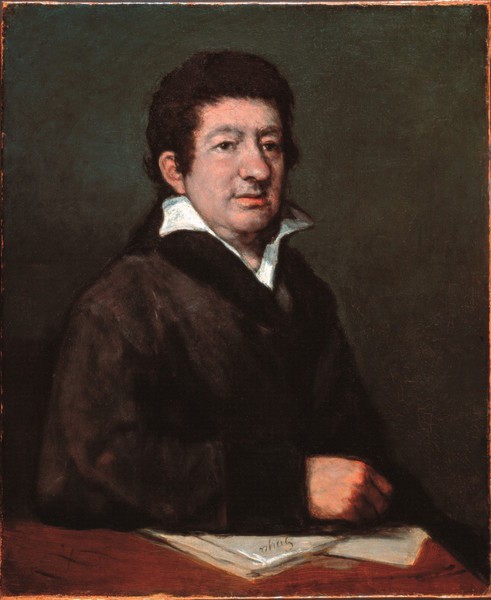- Cronología
- 1824
- Ubicación
- Museum of Fine Arts of Bilbao, Bilbao, Spain
- Dimensiones
- 60 x 49.5 cm
- Técnica y soporte
- Oil on canvas
- Reconocimiento de la autoría de Goya
- Documented work
- Titular
- Bilbao Museum of Fine Arts
- Ficha: realización/revisión
- 30 Mar 2010 / 16 Jun 2023
- Inventario
- (69/111)
Goya (written backwards, on the papers on top of the desk).
Goya painted this portrait in Bordeaux. We are able to deduce the chronology thanks to a letter dated 10 September 1824, sent by Moratín to his close friend, the clergyman and writer Juan Antonio Melón, in which he jokes about the close resemblance, and that the artist wished to "make copies" of him.
The portrait belonged to the collection of Manuel Silvela.
Leandro Nicolás Fernández de Moratín (see biographical information in Moratin) is painted here by his good friend Goya for the second time, when they were both in exile from Spain. Thanks to the letters that the playwright sent to Melón, we know a lot about the last years of Goya's life, spent in Bordeaux.
In this second portrait, we see Moratín depicted frankly, as a man of advancing years, without idealization. His features are no longer as strong as they are in the portrait of the Academy of San Fernando; in fact it would be hard to recognize him as the same man if his friendly face did not give him away. This is no longer a portrait of a young successful writer, but rather that of a friend known for many years, in which sentiment predominates. Moratín has now reached both physical and intellectual maturity, as his knowing look reveals.
In the informal dressing gown that the poet is shown wearing, Goya employed dark tones. His neck is also without a tie, instead being simply framed by the intense white of his shirt collar. That bright white and the pink of his face contrast with the work's background, painted in an unusual bluish green colour. Moratín is shown writing on some pieces of paper, which Goya has taken advantage of to insert his signature. The portrait has a very special expressiveness, reminiscent of modern art, provoked by the marked contours of the figure and the flat application of the background colour, without any perspective.
-
Goya (1746 – 1828)Galleria Internazionale d’Arte Moderna di Ca’PesaroVenecia1989consultant editor Antonio Fortún Paesa. From May 7th to July 4th 1989cat. 52
-
GoyaLa Lonja, Torreón Fortea y Museo Pablo GargalloZaragoza1992consultant editor Julián Gállegocat. 55
-
Realidad e imagen. Goya 1746 – 1828Museo de ZaragozaZaragoza1996consultant editor Federico Torralba Soriano. From October 3th to December 1st 1996cat. 67
-
Francisco de Goya: Maleri, Tegning, GrafikkNasjonalgallerietOslo1996from 10th to April 14th 1996cat. 30
-
Goya y Moratín [En Burdeos, 1824 – 1828]Museo de Bellas Artes de BilbaoBilbao1998consultant editor Françoise Garcíacat. 1
-
Goya’s last WorksThe Frick Art CollectionNew York2006consultant editors Jonathan Brown and Susan Grace Galassi. From February 22nd to May 14th 2006cat. 10
-
Goya y el Mundo ModernoMuseo de ZaragozaZaragoza2008organized by the Fundación Goya en Aragón at the Museo de Zaragoza, consultant editors Valeriano Bozal and Concepción Lomba Serrano. From December 18th 2008 to March 22nd 2009cat. 9
-
Goya e il Mondo ModernoPalazzo RealeMilan2010organized by SEACEX, Palazzo Reale and Fundación Goya en Aragón, consultant editors Valeriano Bozal and Concepción Lomba Serrano. From March 17th to June 27th 2010cat. 10
-
Goya et la modernitéPinacothèque de ParisParís2013from October 11st 2013 to March 16th 2014cat. 129
-
Goya: The PortraitsLondon2015cat. 68
-
GoyaBasle2021p. 351
-
Goya, pintor de retratos, t. IMadridBlass y Cía1916pp. 86-88
-
L'œuvre peint de Goya. 4 volsParís1928-1950vol. II, p. 232, cat. 523
-
Vie et ouvre de Francisco de GoyaParísOffice du livre1970pp. 334, 356, 361, cat. 1661
-
BarcelonaPolígrafa1970vol. I, p. 385, cat. 737
-
L’opera pittorica completa di GoyaMilanRizzoli1974p. 135, cat. 658
-
DiplomatarioZaragozaInstitución Fernando el Católico1981p. 498, nº CLII
-
Francisco de Goya, 4 vols.ZaragozaCaja de Ahorros de Zaragoza, Aragón y Rioja1980-1982vol. IV, p. 199 y p. 209 (il.)
-
GoyaZaragozaElecta1992p. 142, cat. 55 y p. 143 (il.)
-
Realidad e imagen. Goya 1746 – 1828MadridGobierno de Aragón y Electa España1996p. 186, cat. 67 y p. 187 (il.)
-
Goya’s last worksNew YorkThe Frick Collection and Yale University Press2006p. 106, cat. 10 y p. 107 (il.)
-
LondonNational Gallery Company2015pp. 200-201
